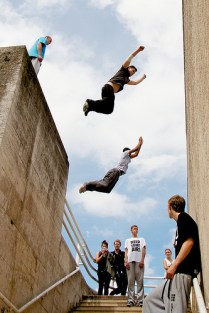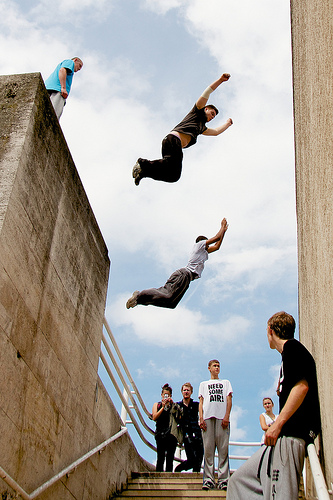
Photo by JB London.
Since gaining a foothold in the U.S. in the early 2000s, bolstered by pop culture (think: the opening scene of Casino Royale), parkour’s popularity has grown steadily, if slowly, in this country. Numerous informal organizations promote and teach this art of urban acrobatics, and a proliferation of YouTube videos show traceurs “freerunning” through the cityscape.
Still, many cities view parkour enthusiasts as lawless street ruffians, akin to skateboarders and street artists. In Manhattan’s Battery Park area, a “No Parkour” rule slaps practitioners with a $300 fine. In Hollister, Calif., anyone seen doing parkour is charged with trespassing. In November, the city of Margate, Fla., just north of Miami, banned the sport from all city parks, citing liability concerns. Mayor Pam Donovan said she thinks the sport is “dangerous and I’m never going to change my mind.”
Gradually, however, the sport seems to be gaining some acceptance — as a tourist spectacle, if nothing else. Parkour competitions featuring professional traceurs have been around for a few years: The Red Bull-sponsored Art of Motion events are big both in Europe and the U.S. But could street parkour, like street art, come out of the shadows and become an economic boon for cities?
This November, the city of Miami will find out when it hosts the first large-scale, international, amateur parkour event in the U.S. Some 125 freerunners from 40 countries will descend on the city for the three-day Cross Urban Scramble. A parkour arena in Bayfront Park will house singles and team competitions. Other activities will include a film festival, rock climbing, and an open forum about parkour insurance and safety.
Roch Nakajima, the co-founder of Parkulture, the organization sponsoring the event, says the goal is to bring a “global perspective” to the sport in the United States — already, teams from Palestine, South Africa, and Russia are scheduled to compete. But he also hopes the event will be accompanied by a substantial infusion of cash, from tourists and locals alike, earning it some much needed credibility among city officials.
Two recruiters from Cirque du Soleil will help judge the competition, Nakajima says, and Parkulture is currently negotiating sponsorships with two branches of the Armed Forces. Still, he admits, getting buy-in from City Hall is tough when “you’re kind of a new sport trying to establish yourself out there.”
Indeed, parkour aficionados have to do a lot of explaining.
Ask Derek Klein, the 25-year-old founder of Miami Parkour, to define his sport, and you’re likely to get hit with a one-sentence apophasis. “We’re not kids throwing ourselves off of rooftops,” he says.
Developed by a soldier’s son and in use by the French military for two decades, parkour “has deep roots in being able to help others,” Klein says. “If you’re climbing a wall in order to help someone who’s dangling off a ledge, you don’t want to act reckless and get injured.”
As unlikely as that might seem, this isn’t Homer Simpson and Ned Flanders doing somersaults atop cars driving on a busy freeway. Klein and the roughly 100 members of his group pull some remarkable stunts, and the serious ones claim to live by an ethic like those you find in martial arts.
“Parkour concentrates on this all around fitness idea of being strong in order to be useful,” Klein says, “and then to know your limits in order to know what you can do with out hesitation.”
In Europe, many cities make room for the sport in special “parkour parks,” similar to skate parks, where people can learn basic skills and hone their moves. Westminster, England’s park is purportedly the largest in the world.
On this side of the pond, Celerity Park in Converse, Texas, on the outskirts of San Antonio, was gunning for the title of first dedicated parkour park in the U.S., but plans have apparently stalled.
For now, the Miami area appears to be on the leading edge. In Margate, where officials banned parkour in November, Klein says that city officials have given traceurs a claim to an old roller derby rink, and are considering a proposal to turn it into a parkour park.
Whether it is a parkour park or an international competition, the major hurdle is insurance, says Nakajima, the organizer of the Cross Urban Scramble. “We are a litigious society,” he says. “There are no benchmarks for parkour that insurance companies have — no risk management plan.”
Still, Nakajima is optimistic that, in this age of X-Games-style stunt shows, he’ll find companies willing to cover his event. Perhaps then the sport will finally vault into the American mainstream. “As long as you get the insurance,” Nakajima says, “cities really don’t care.”



